Darryl Pottorf Photographs
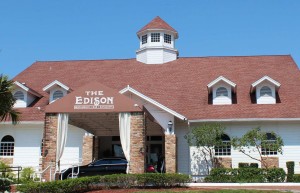 In 1990, Captiva artist Darryl Pottorf was commissioned to create some works of art for Tootie McGregor’s Gulfshore Grille, a restaurant located at the Fort Myers Country Club under lease by the city. Pottorf immersed himself in the archives of the local library, where he located a dozen historical images featuring iconic landmarks, lush tropical foliage and the city’s most famed resident, Thomas Alva Edison. With the City’s blessing, he took the photographs to the the old print shop studio on the 35-acre Captiva estate of his friend and mentor, internationally-renowned artist Robert Rauschenberg. Using a new solvent transfer process being developed by the Rauschenberg studio at that time, Pottorf converted the photos into single edition (1 of 1) prints on Arches paper.
In 1990, Captiva artist Darryl Pottorf was commissioned to create some works of art for Tootie McGregor’s Gulfshore Grille, a restaurant located at the Fort Myers Country Club under lease by the city. Pottorf immersed himself in the archives of the local library, where he located a dozen historical images featuring iconic landmarks, lush tropical foliage and the city’s most famed resident, Thomas Alva Edison. With the City’s blessing, he took the photographs to the the old print shop studio on the 35-acre Captiva estate of his friend and mentor, internationally-renowned artist Robert Rauschenberg. Using a new solvent transfer process being developed by the Rauschenberg studio at that time, Pottorf converted the photos into single edition (1 of 1) prints on Arches paper.
The 12 framed works adorned the popular restaurant’s walls until its closing a number of years later. While a few were moved to various city offices, most of the prints were placed in the club’s storage area where, sadly, they began to deteriorate. Recognizing the importance of these works and the growing worldwide reputation of their maker, the City of Fort Myers Public Art Committee voted in 2008 to have the stored prints conserved.
The prints were remanded into the care of Al Schuth of The Great Frame Up on Gladiolus Boulevard. Schuth rematted the prints, repaired their frames, and buffed the scratches out of their Plexiglas covers at a cost of $2,981.52. In September of 2010, the restored works were hung on anti-theft security hooks in the lobby of the Oscar M. Corbin Jr. City Hall, where they are now on permanent display as part of the City of Fort Myers public art collection.
The Prints
Nine of Pottorf’s prints grace the lobby of City Hall:
- a 41 x 49 inch image of McGregor Boulevard, the dirt cattle trail that was widened and paved at the behest of developer and civic leader Tootie McGregor Terry and lined with royal palm trees by Thomas Edison;
- a 49 x 41 inch portrait of famed winter resident and inventor Thomas Alva Edison, who grew and tested more than 500 local plants and botanicals at his laboratory on the Caloosahatchee River in an effort to develop a local source of latex from which to make tires for friends Henry Ford and Harvey Firestone;
- a 41 x 49 inch print of a seated Thomas Edison;
- a 49 x 40 inch portrait of Uncommon Friends Thomas Edison, Henry Ford and Harvey Firestone;
- a 49 x 36 inch picture of the Edison Theatre;
- a 49 x 36 inch picture of the bronze palm fronds and granite orb that top the Tootie McGregor Fountain;
- a 49 x 36 inch image of Rachel at the Well, the Greek maiden sculpted by German immigrant Helmuth von Zengen for James D. Newton’s grand entrance for his seminal Fort Myers’ development, Edison Park; and
- two 32 x 29 inch images of white birds of paradise.
About Darryl Pottorf
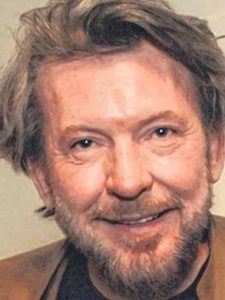 Since 1981, Darryl Pottorf has been creating complex, inspiring works that continually challenge the boundaries of both medium and subject matter. An immensely talented storyteller, his pieces have been described by art critics and curators as lyrical, robust, beautifully composed, bold, expressive, perceptive and ultimately satisfying.
Since 1981, Darryl Pottorf has been creating complex, inspiring works that continually challenge the boundaries of both medium and subject matter. An immensely talented storyteller, his pieces have been described by art critics and curators as lyrical, robust, beautifully composed, bold, expressive, perceptive and ultimately satisfying.
Pottorf was born in Cincinnati, Ohio in 1952, but raised in Southwest Florida. Educated both as an artist (including dance and set design), architect and archeologist (once participating in an Etruscan dig outside Florence, Italy), all three disciplines inform his visually provocative content which is based on disparate photographic images he 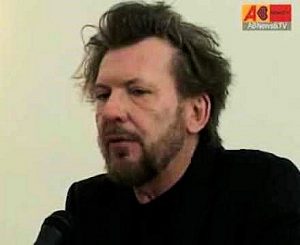 has collected during extensive worldwide travels. Using these collected images as a palette much like a painter uses pigment, Pottorf creates two-dimensional mixed-media works by transferring agglomerated images onto paper and overpainting them, sometimes with a grid of crisp lines, sometimes with more painterly strokes. By enmeshing cultures and images, Pottorf places himself squarely
has collected during extensive worldwide travels. Using these collected images as a palette much like a painter uses pigment, Pottorf creates two-dimensional mixed-media works by transferring agglomerated images onto paper and overpainting them, sometimes with a grid of crisp lines, sometimes with more painterly strokes. By enmeshing cultures and images, Pottorf places himself squarely 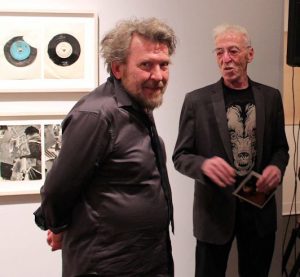 in the post-modern camp, with his works possessing the restlessness of a jump-cut music video coupled with a classical equanimity.
in the post-modern camp, with his works possessing the restlessness of a jump-cut music video coupled with a classical equanimity.
Pottorf’s works have the physical attributes of oil on canvas and the surface delicacy of watercolor. In the early 1990s he developed a technique for transferring existing images onto paper using water-based media. His invention precludes the need for glass, since he poly-laminates the paper directly onto panels and treats it with a coating that filters ultraviolet 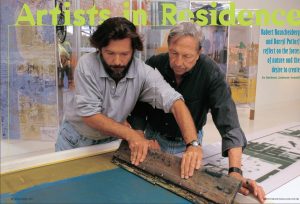 light.
light.
The artist was a student and later a colleague of pop art icon Robert Rauschenberg, whom he met while taking a printmaking class at Edison Community College. He became Rauschenberg’s Chief Studio Assistant, although his tutelage began with painting Rauschenberg’s garage, hauling lumber, and swabbing 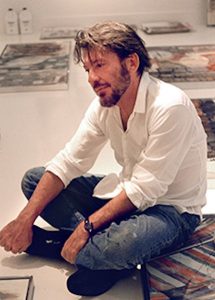 his decks before he actually was allowed to assist Rauschenberg in his studio. Pottorf worked with Rauschenberg on such groundbreaking projects as ROCI (Rauschenberg Overseas Cultural Interchange, Rauschenberg’s 8 year, peace-seeking art odyssey that visited, made art and exhibited in 11 countries) – as well as Gluts, Urban Bourban, Shiner, the Galvanic Suite series and Rauschenberg’s monumental Quarter of a Mile or Two Furlong Piece. In 1995, their artistic collaboration culminated in Quatro Mani (Four Hands) in Venice, Italy.
his decks before he actually was allowed to assist Rauschenberg in his studio. Pottorf worked with Rauschenberg on such groundbreaking projects as ROCI (Rauschenberg Overseas Cultural Interchange, Rauschenberg’s 8 year, peace-seeking art odyssey that visited, made art and exhibited in 11 countries) – as well as Gluts, Urban Bourban, Shiner, the Galvanic Suite series and Rauschenberg’s monumental Quarter of a Mile or Two Furlong Piece. In 1995, their artistic collaboration culminated in Quatro Mani (Four Hands) in Venice, Italy.
Along the way, Rauschenberg and Pottorf traveled to China, Africa, Russia (where they met with Gorbachev) and Cuba (where they stayed at Fidel Castro’s beach house). 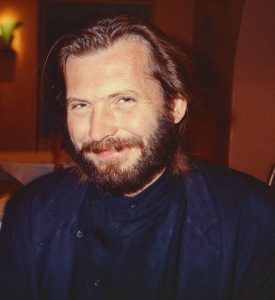 They were in Berlin when the wall came down. They enjoyed the hospitality of Malaysian headhunters, spent a week with the Dalai Lama, and mingled with a cross-section of luminaries including Hillary Clinton, Muhammad Ali, Elizabeth Taylor, Lauren Hutton, Lily Tomlin and Sharon Stone.
They were in Berlin when the wall came down. They enjoyed the hospitality of Malaysian headhunters, spent a week with the Dalai Lama, and mingled with a cross-section of luminaries including Hillary Clinton, Muhammad Ali, Elizabeth Taylor, Lauren Hutton, Lily Tomlin and Sharon Stone.
Rauschenberg described Pottorf’s work “as proof and witness of change even when no one is watching. The fixed images have the appearance of an archeological dig that seems to be uncovered within the surface.”
Pottorf’s 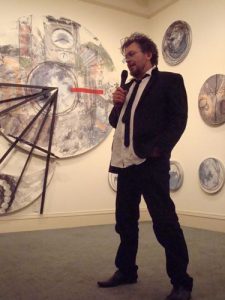 mediums include UV-coated watercolor and polylaminate, black and silver toner on lexan, and acrylic on aluminum. With each of these mediums, he employs the photo transfer process that he began using in the late eighties, first in black and white and then in color, which has come to characterize his more recent output.
mediums include UV-coated watercolor and polylaminate, black and silver toner on lexan, and acrylic on aluminum. With each of these mediums, he employs the photo transfer process that he began using in the late eighties, first in black and white and then in color, which has come to characterize his more recent output.
Pottorf possesses B.A. in Art from Florida State University, with the bulk of his studies taking place in Florence, Italy. His work has been exhibited at galleries and museums around the world, including Mathew Marks, Gagosian, and the Metropolitan Museum of Art in New York; the Dallas Museum of Art in Texas; the Evansville Museum in Indiana; 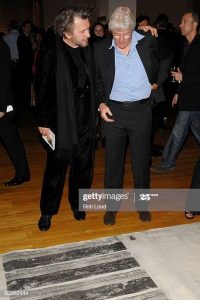 Ohio’s Butler Museum of Art; the Tinguely Museum in Basel, Switzerland; the Art Basel Miami International Art Exhibition; and the Patty & Jay Baker Naples Museum of Art in Naples, Florida.
Ohio’s Butler Museum of Art; the Tinguely Museum in Basel, Switzerland; the Art Basel Miami International Art Exhibition; and the Patty & Jay Baker Naples Museum of Art in Naples, Florida.
The artist is also known for founding with his sister Jennifer Benton the annual auction that benefits ACT (which initially drew about 200 attendees and the work of only local artists, but which has gone on to be hosted by celebrities such as Sharon Stone, Lilly Tomlin and Meryl Streep and raise over $400,000). His philanthropy has also extended to CROW, the Zimmerman Children’s Museum, the Gulf Coast Humane Society, the Animal Refuge Center, the Children’s Hospital at Lee Memorial, 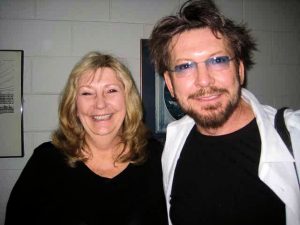 The Coalition of the Homeless and the Juvenile Diabetes Research Foundation.
The Coalition of the Homeless and the Juvenile Diabetes Research Foundation.
His nine prints on display at City Hall in Fort Myers are the only Pottorf works in the permanent collection of a public art program anywhere in the world.
About the Solvent Transfer Print Process
The 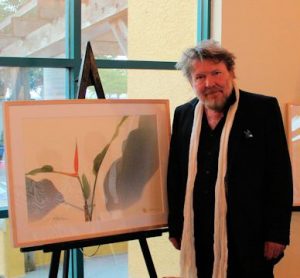 solvent transfer process involves “borrowing” subject matter from printed media, photos and graphics, chemically dissolving them, and transferring the image onto a new surface. Much as a photographer can manipulate the camera image in many ways, the solvent transfer can be changed, arranged, composed and continually altered to express the artist’s aims. Additional treatment with drawing or painting techniques may contribute to the uniqueness of each print.
solvent transfer process involves “borrowing” subject matter from printed media, photos and graphics, chemically dissolving them, and transferring the image onto a new surface. Much as a photographer can manipulate the camera image in many ways, the solvent transfer can be changed, arranged, composed and continually altered to express the artist’s aims. Additional treatment with drawing or painting techniques may contribute to the uniqueness of each print. 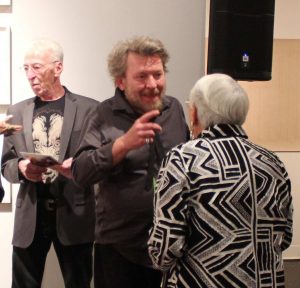 Although called transfer prints, each is one-of-a-kind.
Although called transfer prints, each is one-of-a-kind.
The process was brought to prominence and new levels of expressiveness in the late 1950s by Robert Rauschenberg, who dissolved printed images from newspapers and magazines with a solvent and then rubbed them onto paper with a pencil. “The process, used for works like ’34 Drawings for Dante’s Inferno,’ created the impression of something fugitive, exquisite and secret,” wrote art critic Michael Kimmelman 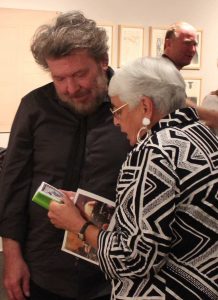 in his May 14, 2008 obituary of the iconic artist. “Perhaps there was an autobiographical and sensual aspect to this. It let him blend images on a surface to a kind of surreal effect, which became the basis for works he made throughout his later career, when he adapted the transfer method to canvas.
in his May 14, 2008 obituary of the iconic artist. “Perhaps there was an autobiographical and sensual aspect to this. It let him blend images on a surface to a kind of surreal effect, which became the basis for works he made throughout his later career, when he adapted the transfer method to canvas.
In the case of the 1991 prints:
- First, Pottorf selected as his subject an historic old photograph from the city’s archive of images.
- Next, he laid each photograph face down on a sheet of Arches paper, a type of air-dried, 100% cotton-fiber paper favored by printers and watercolorists. It has a warm-white colour and can be found in hot-pressed, cold-pressed and rough varieties. Valued for its durability and still made today at the Arches paper mill in Lorraine, France, Arches paper is acid-free, pH neutral and gelatin sized.
- Then, Pottorf coated the back of the photograph with acetone or Xylene, burnishing the photo with a spoon, brayer, bone folder or other instrument designed to cause the image on the photograph to transfer to the paper.
- That done, the photograph is lifted off the paper, leaving the transferred image on the Arches paper.
The process similar to, but far less time-consuming than, silkscreening, which Rauschenberg also explored beginning around 1962 (around the same time as Andy Warhol, who often traded ideas with Rauschenberg about the technique). Both forms of printmaking uniquely enabled Rauschenberg to quickly and repetitively transfer his found imagery to the canvas of his paintings and Combines.
Location, Material and Measurements.
- The collection is located in the lobby outside the City Council chambers at the Oscar M. Corbin, Jr. City Hall at 2200 Second Street, Fort Myers, FL 33901.
- The collection is at latitude N 26 d 38′ 32.0713″ and longitude W 81 d 52′ 7.478″.
- The prints are made from black and white photographs conveyed to Arches paper by solvent transfer process.
Fast Facts.
- Rauschenberg’s print shop is one of five white-framed buildings on his 30-acre seaside estate
- Tootie McGregor’s Gulfshore Grille was located at 583 McGregor Boulevard.
- Veranda owner Paul Peden and executive chef William Murray headed Tootie McGregor’s culinary team.
- The Great Frame Up is located at 8646 Gladiolus Drive in Fort Myers 33908-4107.














 Tom Hall is both an amateur artist and aspiring novelist who writes art quest thrillers. He is in the final stages of completing his debut novel titled "Art Detective," a story that fictionalizes the discovery of the fabled billion-dollar Impressionist collection of Parisian art dealer Josse Bernheim-Jeune, thought by many to have perished during World War II when the collection's hiding place, Castle de Rastignac in southern France, was destroyed by the Wehrmacht in reprisal for attacks made by members of the Resistance operating in the area. A former tax attorney, Tom holds a bachelor's degree as well as both a juris doctorate and masters of laws in taxation from the University of Florida. Tom lives in Estero, Florida with his fiancee, Connie, and their four cats.
Tom Hall is both an amateur artist and aspiring novelist who writes art quest thrillers. He is in the final stages of completing his debut novel titled "Art Detective," a story that fictionalizes the discovery of the fabled billion-dollar Impressionist collection of Parisian art dealer Josse Bernheim-Jeune, thought by many to have perished during World War II when the collection's hiding place, Castle de Rastignac in southern France, was destroyed by the Wehrmacht in reprisal for attacks made by members of the Resistance operating in the area. A former tax attorney, Tom holds a bachelor's degree as well as both a juris doctorate and masters of laws in taxation from the University of Florida. Tom lives in Estero, Florida with his fiancee, Connie, and their four cats.